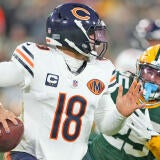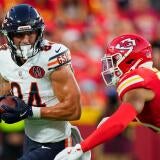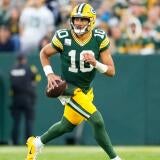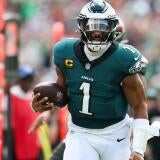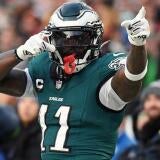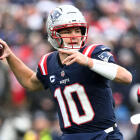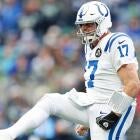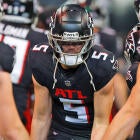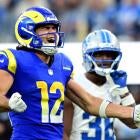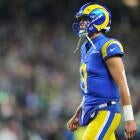2020 Super Bowl: Comparing Andy Reid's Chiefs to 2004 Eagles, the last Reid-coached team to reach Super Bowl
Are Reid's Chiefs better on paper than his 2004 Eagles?
Andy Reid is back in the Super Bowl after a 15-year hiatus. Things have certainly changed around the NFL since the Kansas City Chiefs head coach last reached the Super Bowl as the head coach of the Philadelphia Eagles in the 2004 season. Reid and Bill Belichick remain the only two head coaches from that era to coach every season since, demonstrating their longevity and ability to adapt to the ever-changing NFL.
The last time Reid coached in a Super Bowl, "Let Me Love You" by Mario was the No. 1 song and gas was an average of $1.90 per gallon. Paul Tagliabue was the NFL commissioner and the league still allowed defensive players to "horse-collar tackle" opposing ball carriers.
Reid's teams have certainly changed over the 15 years between Super Bowl appearances. The 2004 Philadelphia Eagles (13-3) were the class of the NFC with two Hall of Fame players on their roster (Terrell Owens and Brian Dawkins). The 2019 Kansas City Chiefs (12-4) have a few players who appear to have a chance of heading to Canton when their careers are over.
So how good are Reid's chances to win the Super Bowl this time? Comparing the 2019 Chiefs to his 2004 Eagles, Reid appears to have a better team with this year's group:
Quarterback
2004 Eagles: Donovan McNabb
2019 Chiefs: Patrick Mahomes
Mahomes clearly has the edge over McNabb here. The NFL is more catered to offenses now than when the Eagles made the Super Bowl, as McNabb was the first quarterback in league history to throw for 30 touchdown passes and have less than 10 interceptions in a season. McNabb made the Pro Bowl and had a 104.7 passer rating that season, but his running skills and scrambling ability were starting to decline.
Mahomes is one of the youngest quarterbacks to make the Super Bowl, throwing for 4,031 yards, 26 touchdowns to just five interceptions in 14 games (105.3 rating), despite playing most of the year at less than 100 percent. His postseason numbers are staggering (615 yards, eight touchdowns, zero interceptions), as he is playing his best football at 100 percent health. Mahomes has played only two full seasons, yet already has an MVP award and is arguably the best quarterback in football.
Who should you put your money on to be Super Bowl LIV MVP? And what can we expect from the Andy Reid-Kyle Shanahan coaching matchup? Brady Quinn and John Breech join Will Brinson to break it all down on the Pick Six Podcast. Listen below and be sure to subscribe here for daily NFL goodness fired into your eardrums.
Running Back
2004 Eagles: Brian Westbrook, Dorsey Levens
2019 Chiefs: Damien Williams, LeSean McCoy
Westbrook has the edge, as he averaged 6.1 yards per touch and had 1,515 scrimmage yards in 2004. One of the most explosive backs in the NFL, Westbrook had 703 receiving yards and six touchdowns with his 812 rushing yards (4.6 yards per carry). Levens was a solid backup, having 410 rushing yards (4.4 yards per carry) and two touchdowns, even though the Eagles were only 24th in the league in rushing.
The Chiefs also did a running back-by-committee with Williams and McCoy, with neither having more than 500 rushing yards and 750 yards from scrimmage. Williams had 498 rushing yards and seven total touchdowns, averaging 5.0 yards per touch. McCoy averaged 4.6 yards per carry at 31, but his usage was limited throughout the year. The Chiefs finished 23rd in the league in rushing.
Wide Receiver
2004 Eagles: Terrell Owens, Todd Pinkston, Freddie Mitchell, Greg Lewis
2019 Chiefs: Tyreek Hill, Sammy Watkins, Mecole Hardman, Demarcus Robinson
Owens (77 catches, 1,200 yards, 14 TD) is the best player of the bunch, but the Chiefs have the edge thanks to their depth. Philadelphia got to the Super Bowl with Owens sidelined, and Pinkston (18.8 yards per catch) was the lone field stretcher on the roster. Owens famously beat his recovery timetable and returned for the big game.
The Chiefs have speed all over the field with Hill (14.8 YPC, 7 TD) and Hardman (20.7 YPC, 6 TD), allowing Mahomes to air the ball downfield and stretch the offense. The Chiefs' top four wide receivers each had over 400 receiving yards, despite Hill and Watkins missing multiple games with injuries. Lewis, who caught a touchdown pass in Super Bowl XXXIX, is the Chiefs wide receivers coach.
Tight End
2004 Eagles: L.J. Smith, Chad Lewis
2019 Chiefs: Travis Kelce
Kelce is arguably the best tight end in the NFL and one of the greatest in the history of the league after his first seven seasons. Kelce led the Chiefs in catches (97) and yards (1,229) with five touchdowns. He was also Mahomes' go-to target on third down and frees up the wide receivers to run downfield and make big plays. The Chiefs have the edge here.
Smith was largely a disappointment throughout his Eagles career, but was a presence in the red zone with five touchdowns (and only 377 receiving yards). Lewis missed the Super Bowl with a broken foot, but had 267 receiving yards and three touchdowns as the No. 2 tight end. The Eagles would run "12" personnel (two tight ends) with Smith and Lewis.
Offensive Line
2004 Eagles: Tra Thomas (LT), Artis Hicks (LG), Hank Fraley (C), Jermane Mayberry (RG), Jon Runyan (RT)
2019 Chiefs: Eric Fisher (LT), Stefen Wisniewski (LG), Austin Reiter (C), Laurent Duvernay-Tardif (RG), Mitchell Schwartz (RT)
Thomas and Runyan were the best tackle tandem in the NFL for a decade -- the bookends of an Eagles offensive line that was consistently among the NFL's best. Thomas was the Eagles' only offensive lineman to make the Pro Bowl that year, but Runyan and Mayberry had made Pro Bowls previously in their careers. Hicks filled in at left guard for Mayberry, who replaced Shawn Andrews after a season-ending injury in Week 1 (Andrews made consecutive Pro Bowls over the next two years at guard).
Schwartz is one of the best right tackles in the game and Duvernay-Tardif continues to be underrated at his position. The Chiefs have a strong right side of the line, but they are known for pass protection and buying Mahomes time than pushing the line.
Runyan and Thomas give the Eagles the edge here.
Defensive Line
2004 Eagles: Jevon Kearse (DE), Corey Simon (DT), Darwin Walker (DT), Derrick Burgess (DE)
2019 Chiefs: Frank Clark (DE), Alex Okafor (DE), Chris Jones (DT), Derrick Nnadi (DT), Tanoh Kpassagnon (DE)
Defensive formations have been altered since the Eagles were last in the Super Bowl, but Philadelphia had some star power on the edge with Kearse (who was the highest-paid defensive end in the NFL). Kearse had 7.5 sacks and two forced fumbles, leading the Eagles in both categories. It was a good group despite not having a player with double-digit sacks, finishing second in the NFL with 47 sacks and tied for eighth with 29 forced fumbles, a staple under former defensive coordinator Jim Johnson.
The Chiefs had 45 sacks in 2019, which was 11th in the NFL. Jones is one of the best pass-rushing defensive tackles in the game, leading the team with nine sacks while offseason acquisition Frank Clark had eight. The Chiefs had four edge rushers that finished with 4-plus sacks, allowing defensive coordinator Steve Spagnuolo (a Johnson protege) to rotate throughout the game.
The Eagles get a slight edge here, especially since they finished 16th in rush yards allowed compared to the Chiefs finishing 26th. Kansas City had better edge rushers, but Philadelphia was stronger on the interior defensive line.
Linebacker
2004 Eagles: Jeremiah Trotter (MLB), Mark Simoneau (OLB), Dhani Jones (OLB)
2019 Chiefs: Anthony Hitchens (LB), Damien Wilson (LB)
The Eagles linebackers had a Pro Bowler in Trotter, who was one of the stars on a defense that finished second in the NFL in points allowed. Trotter solidified the Eagles run defense when he finally earned a starting job in the middle of the season after earning his way back in the lineup after a late August release by the Redskins. Jones and Simoneau were solid coverage linebackers, but Keith Adams took more snaps from Simoneau in the playoffs because he was a better tackler. Nate Wayne started seven games, but was benched in favor of Trotter.
Hitchens and Wilson are better coverage linebackers than Jones and Simoneau were. The Chiefs would move Tyrann Mathieu down to the box to play the slot, which improves the unit. Going on talent, Trotter would give the Eagles the edge, but the Chiefs pass defense finished eighth because of their linebackers. We'll give a slight edge to Kansas City.
Secondary
2004 Eagles: Lito Sheppard (CB), Sheldon Brown (CB), Brian Dawkins (FS), Michael Lewis (SS)
2019 Chiefs: Bashaud Breeland (CB), Charvarius Ward (CB), Tyrann Mathieu (S), Juan Thornhill (S)
The Eagles clearly have the edge here, having a Hall of Famer in Dawkins (three sacks, four INT) who lead a group that had two first team All-Pro players (Dawkins, Sheppard) and three Pro Bowlers (Dawkins, Sheppard, Brown). Lewis and Dawkins were two of the best pass coverage safeties in the NFL while Sheppard had five interceptions in his first full season as a starter. The Eagles allowed just 16 passing touchdowns on the year (third-fewest in NFL) despite finishing with just 17 interceptions (16th in NFL).
Breeland and Ward are solid cornerbacks, but they don't match up to the talent of Sheppard and Brown. Mathieu (two sacks, four INT) and Thornhill (three INT) are emerging as one of the best safety tandems in the league, but Thornhill will be out for the Super Bowl (torn ACL). Kendall Fuller has been getting the reps as a third cornerback/starting safety.
Special Teams
2004 Eagles: David Akers (K), Dirk Johnson (P), J.R. Reed (KR), Reho Mahe (PR)
2019 Chiefs: Harrison Butker (K), Dustin Colquitt (P), Mecole Hardman (KR/PR)
The Eagles had a Pro Bowl special teamer in Ike Reese, who also contributed at linebacker, but the Chiefs have the edge thanks to Hardman's return ability. Hardman averaged 26.1 yards per kick return with a touchdown and 9.3 yards per punt return. Butker converted 93.8% of his field goal attempts and led the league with 34 field goals.
Kicking in the NFL was different 15 years ago, but Akers made the Pro Bowl converting 84.4% of his kicks. Akers was arguably one of the best kickers in the NFC, making three Pro Bowls over a four-year stretch from 2001 to 2004. Reed averaged 23.7 yards per kick return while Mahe averaged 5.7 yards on punt returns.


